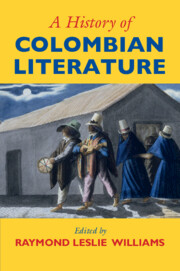Book contents
- Frontmatter
- Contents
- Notes on contributors
- Preface
- Introduction
- PART I LITERATURE AND SOCIETY IN COLOMBIA
- 1 Colonial realities and colonial literature in “Colombia”
- 2 Cosmography, ethnography, and the literary imagination of the New Kingdom of Granada
- 3 Colombian poetry from the colonial period to Modernismo (1500–1920)
- 4 Reflections on the historiography of the Colombian novel: 1844–1953 and beyond
- 5 Modern Colombian poetry: from modernismo to the twenty-first century
- 6 The late twentieth-century Colombian novel (1970–1999)
- 7 Twenty-first century fiction
- 8 Colombian theater: staging the sociopolitical body
- 9 The Colombian essay
- PART II COLOMBIAN CULTURE AND SOCIETY IN REGIONAL CONTEXTS
- PART III BEYOND THE BOUNDARIES
- AFTERWORDS
- Index
- References
7 - Twenty-first century fiction
from PART I - LITERATURE AND SOCIETY IN COLOMBIA
Published online by Cambridge University Press: 05 June 2016
- Frontmatter
- Contents
- Notes on contributors
- Preface
- Introduction
- PART I LITERATURE AND SOCIETY IN COLOMBIA
- 1 Colonial realities and colonial literature in “Colombia”
- 2 Cosmography, ethnography, and the literary imagination of the New Kingdom of Granada
- 3 Colombian poetry from the colonial period to Modernismo (1500–1920)
- 4 Reflections on the historiography of the Colombian novel: 1844–1953 and beyond
- 5 Modern Colombian poetry: from modernismo to the twenty-first century
- 6 The late twentieth-century Colombian novel (1970–1999)
- 7 Twenty-first century fiction
- 8 Colombian theater: staging the sociopolitical body
- 9 The Colombian essay
- PART II COLOMBIAN CULTURE AND SOCIETY IN REGIONAL CONTEXTS
- PART III BEYOND THE BOUNDARIES
- AFTERWORDS
- Index
- References
Summary
Introduction
The Colombian novel of the twenty-first century is a heterogeneous genre of multiple tendencies published by three generations of writers. In addition, with the rise of the new technologies since the early 1990s, the new digital genre offers a different concept of what a novel might be. In the twenty-first century, the most visible generation consisted of the writers known in Latin America as the “McOndo” generation, also identified as the “Crack” generation in Mexico and the Generation of the 1990s in Brazil. This generation was born in the 1960s, began publishing in the 1990s, and includes most prominently Mario Mendoza (b. 1964), Jorge Franco (b. 1962) Santiago Gamboa (b. 1965), Efraim Medina Reyes (b. 1967), Juan Carlos Botero (b. 1960), Octavio Escobar Giraldo (b. 1962), Pablo Montoya (b. 1963), and Enrique Serrano (b. 1960). The generation that preceded it began publishing earlier (in the 1970s and 1980s), and these writers, such as Fernando Vallejo (b. 1942), Darío Jaramillo (b. 1947), Laura Restrepo (b. 1950), Albalucía Angel (b. 1939), Fanny Buitrago (b. 1945), Ramón Illán Baca (b. 1942), Héctor Abad Facciolince (b. 1958), Evelio Rosero (b. 1958), Roberto Burgos (b. 1948), Oscar Collazos (b. 1942), Piedad Bonnet (b. 1951), William Ospina (b. 1954), Azriel Bibliowicz (b. 1949), Gustavo Alvarez Gardeazábal (b. 1945), José Gabriel Baena (b. 1952), and Tomás González (b. 1952), have all published a significant body of work that began appearing in the 1970s and 1980s. With respect to the youngest generation that followed the Generation of the 1990s, born since 1970 are Juan Gabriel Vásquez, Ricardo Silva Romero (1970 b.), Juan Manuel Ruiz, and Juan B. Gutiérrez. In this chapter, we will provide a brief overview of these three generations and then discuss some major topics of twenty-first century writing: the new urban violence, sicaresque and urban neorealism, exile and new experience of urban space, and new digital genres.
Three generations of writers
Of the three generations of writers, a Generation of the 1990s has been widely discussed since the mid-1990s, but there is little agreement about exactly what they represent. In general, these writers have rejected some aspects of the 1960s Boom, particularly the magical realism that in Colombia they associate with García Márquez but also, to some degree, with the popular commercial writer Isabel Allende.
- Type
- Chapter
- Information
- A History of Colombian Literature , pp. 143 - 162Publisher: Cambridge University PressPrint publication year: 2016
References
- 3
- Cited by

